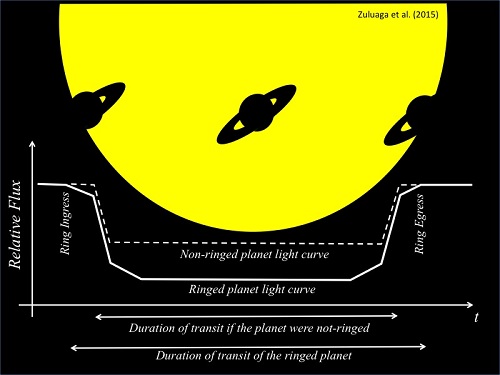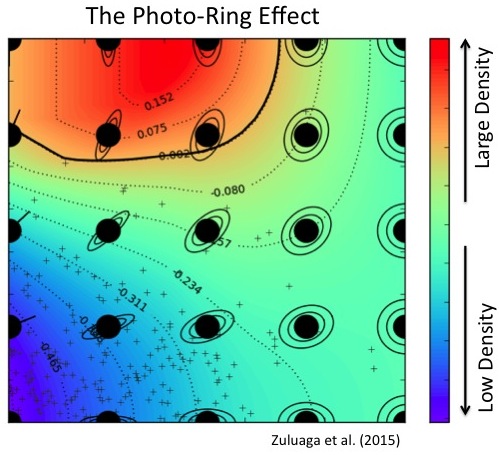Not long ago we looked at the discovery of what appears to be a disk orbiting the huge gas giant J1407b (see Enormous Ring System Hints of Exomoons). The example of Saturn is one thing that makes us wonder whether rings might exist around exoplanets, but of course in our own Solar System we also have Jupiter, Uranus and Neptune as hosts of ring systems of different sizes. In the case of J1407b, we’re not strictly sure that the object is a planet. If it’s actually a brown dwarf, we might be observing a protoplanetary disk in a young system.
I’m not surprised when it comes to looking for ring systems around exoplanets that David Kipping (Harvard-Smithsonian Center for Astrophysics) should be in the mix. Working with Jorge Zuluaga (University of Antioquia) and two of their students, Kipping is co-author of a paper discussing how we might identify what are now being called ‘exorings.’ As illustrated in the figure below, an exoplanet’s transit signature is a key, taking advantage of the fact that a planet with a ring system will produce a longer, deeper transit than the same planet without any rings.

Image: Schematic representation of the transit of a ringed planet in front of its star. When compared with the light curve of an non-ringed analogue (dashed line) the transit of a ringed planet is deeper (the relative flux diminishes by a larger fraction) and longer. Credit: Jorge Zuluaga/David Kipping.
The trick here is to separate the effect of a larger planet seen in transit from a smaller world with a ring system. The paper explains that in transit studies, objects that appear larger than expected are often classed as false positives, a category that the authors think merits a careful look in case what is being rejected is actually a planet with a ring system. From the paper:
The transits of a Saturn-like ringed-planet are up to ?3 times deeper than that expected for a spherical non-ringed one. These deep transits will be interpreted as produced by a planet ?1.7 times larger. Additionally, if independent estimations of its mass were also available, the density of the planet will be underestimated by a factor of ?5. Thus, instead of measuring Saturn’s density ?0.7 g/cm3 , this planet would seem to have an anomalously low density of ?0.14 g/cm3 . Even under more realistic orientations (cosiR ? 0.2) the observed radius will be ?20% larger and the estimated density almost a half of the real one.
It is conceivable, then, that some ‘false-positive’ transits conceal a population of planets with rings.
An effect based on asterodensity profiling that the authors call the ‘photo-ring’ effect also comes into play. Here we examine the transit depth and its duration. The first is related to the size of the star, while the second depends on orbital velocity and the mass of the star. Out of this information we can estimate the star’s density, a result that can be compared with independent density calculations from methods like asteroseismology or the transits of other planetary companions to see if the results coincide. A discrepancy may be telling: The presence of rings around the transiting world, the authors argue, leads to an underestimation of stellar density.
Interestingly, the two effects we seek (anomalous transit depths and photo-ring effect) are complementary with respect to the orientation of the ring plane. For large inclinations and obliquities (face-on rings), the effect on transit depths is significant whilst the photo-ring effect is negligible. Alternatively, if rings have relatively low obliquities (edge-on rings), then the photo-ring effect will be considerable but the depth anomaly small.

Image: Magnitude of the so-called Photo-ring effect predicted by Zuluaga, Kipping et al., at different projected inclinations and tilts (small “saturns”). Credit: Jorge Zuluaga/David Kipping.
The strategies that emerge from this study are thus complementary. We can look for already confirmed transiting planets that appear to have anomalously low densities for further study. We can also reinvestigate our catalog of false-positives due to anomalously large transit depths to see if any of these could mask a ringed planet’s signature. Finally, we can search for transit signals that show the ‘photo-ring’ effect, looking for discrepancies in density calculations.
None of this implies that studying transit lightcurves itself does not remain significant:
We stress that the method presented here is complementary to the methods developed to discover exorings through detailed light curve modelling (Barnes & Fortney 2004; Ohta et al. 2009; Tusnski & Valio 2011). As explained earlier, the role of these methods will be very important once a suitable list of potential exoring candidates [is] found. It is, however, also important to note the great value of light curve models developed under the guiding principle of computational efficiency (semianalytical formulae, efficient numerical procedures, etc.), such as the basic models presented here.
We thus have a relatively straightforward technique for surveying our transiting planet catalogs for ringed-planet candidates, looking for that subset that can be subjected to more detailed lightcurve analysis. The paper is Zuluaga et al., “A Novel Method for Identifying Exoplanetary Rings,” accepted for publication at Astrophysical Journal Letters (preprint).



This from the pre-print (section 5):
“With the exception of Kepler-421b (Kipping et al. 2014b), all of the confirmed planets and most of Kepler candidates are inside the so-called snow-line. Although icy rings, such as those observed around Saturn and Solar System giant planets, seem unlikely inside this limit, the existence of “warm” rocky rings at distances as short as ?0.1 AU, are not dynamically excluded (Schlichting & Chang 2011).”
I was looking for something like this in the paper since ring systems would become unstable when the exoplanet get close to the primary, and many of those discovered exoplanets are closer to their primaries. Without stability there are no ring systems to discover. Rocky rings would block less light than icy rings (due to the lower surface area per a given ring mass), and so less detectable by the proposed method, yet only these are stable in tightly-orbiting exoplanets.
Can anyone put some numbers to these issues?
A way to separate the two maybe to look for polarisation or absorption of parts of the spectrum as the planet transits. Saturn’s rings have an effect of removing/scattering some of the starlight wavelengths due to dust and ice grains. This is another article that looks into the detection of ringed planets by affecting the stars light, a combination of the two methods could yield a better resolution of the issue.
http://arxiv.org/pdf/astro-ph/0406390v1.pdf
Would looking at the transit in different wavelengths, say light and long infrared, help determine if you have rings? Fine dust wouldn’t be scattered by the long IR, so in effect the planet would appear smaller at long wavelengths.
I meant to say long IR wouldn’t be scattered by the fine dust.
I remember there was a proposal to search CoRoT-9b for evidence of rings and satellites but from what I can tell nothing has been published from the observations (if they ever got made?).
hi there,
there is even hope for characterizing the rings by measuring the photometry of planets detected by direct imaging : http://arxiv.org/abs/astro-ph/0403330
regards.
A second minor planet may possess Saturn-like rings
40 minutes ago
There are only five bodies in our solar system that are known to bear rings. The most obvious is the planet Saturn; to a lesser extent, rings of gas and dust also encircle Jupiter, Uranus, and Neptune. The fifth member of this haloed group is Chariklo, one of a class of minor planets called centaurs: small, rocky bodies that possess qualities of both asteroids and comets.
Scientists only recently detected Chariklo’s ring system—a surprising finding, as it had been thought that centaurs are relatively dormant. Now scientists at MIT and elsewhere have detected a possible ring system around a second centaur, Chiron.
In November 2011, the group observed a stellar occultation in which Chiron passed in front of a bright star, briefly blocking its light. The researchers analyzed the star’s light emissions, and the momentary shadow created by Chiron, and identified optical features that suggest the centaur may possess a circulating disk of debris. The team believes the features may signify a ring system, a circular shell of gas and dust, or symmetric jets of material shooting out from the centaur’s surface.
“It’s interesting, because Chiron is a centaur—part of that middle section of the solar system, between Jupiter and Pluto, where we originally weren’t thinking things would be active, but it’s turning out things are quite active,” says Amanda Bosh, a lecturer in MIT’s Department of Earth, Atmospheric and Planetary Sciences.
Bosh and her colleagues at MIT—Jessica Ruprecht, Michael Person, and Amanda Gulbis—have published their results in the journal Icarus.
Full article here:
http://phys.org/news/2015-03-minor-planet-saturn-like.html
There appears (MAYBE) to be a THIRD method to detect exorings. It is called “Fourier Series”. What makes me feel very suspicious of the whole thing is; The authors ALSO claim that exotrojan ASTEROIDS can be detected as well, but no mention* of Ganymede to Mars sized exomoons. The paper, titled “Extracting Periodic Transit Signals from Noisy Light Curves Using Fourier Series”. This paper does NOT appear on Exoplanet.eu. I read the abstract(ONLY: I assume that the entire paper is way over my head, technically), on http://www.voxcharta.org. This non-posting on exoplanet.eu rases my suspicion that this method is quite controvercial, and should be taken with a grain of salt. Since this comment appears on an old post with very few comments, I expect no reader responses to it, thus; I ask the moderater(s) to reply as to their take on the viability of this method (or perhaps even a FUTURE post if the claimed sensitivity of this method has merit. *The last sentence of this abstract is “Our presented method is in general the optimal and least biased estimator and could therefore lesd the way towards the first detections of e.g., planet rings, and trojan asteriods”. What does “e.g.” stand for? Does this have something to do with exomoons? Someone please help me out here.